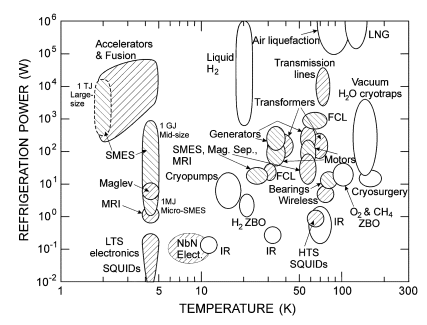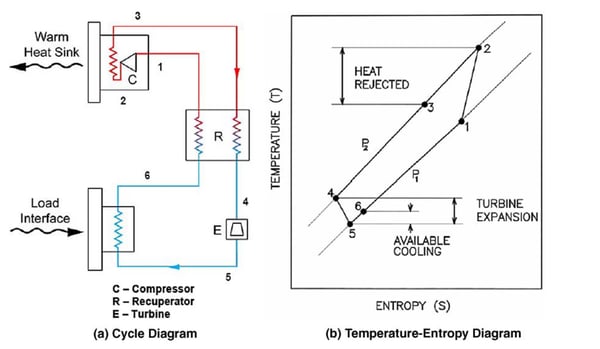The Gyroscopic Effect
This post covers one of the fundamental issues that makes rotordynamics a unique subject: The Gyroscopic Effect. The gyroscopic effect can be observed in the behavior of spinning tops, fidget...
A blog on what's new, notable, and next in turbomachinery
Perhaps it is because Spring is so slow to come this year, but I have been thinking a lot about refrigeration and the different types of systems there are. Refrigeration systems that operate below 120 K are commonly referred to as cryocoolers. Figure 1 illustrates the most common usage of cryocoolers in the fields of superconductivity, liquefaction, and infrared sensors. As you can see, cryocoolers cover a wide range in temperatures, cooling loads, and applications.

Figure 1. Applications for Cryocoolers (Image credit: Radebaugh, 2004)
There are several different types of cryocoolers, each specialized for the requirements of their application. They can be broadly categorized into recuperative (Joule-Thompson and Brayton) and regenerative (Gifford-McMahon, Stirling, pulse tube) cycles. There is another, the Claude Cycle, which is commonly used in large liquefaction systems. The Claude Cycle is a special case of the recuperative cycle where a Brayton cycle is followed by single-stage Joule-Thompson expansion.
Stirling and Gifford-McMahon refrigerators are commonly used in the cryogenics industry. These refrigerators have some limitations; namely, they do not scale well and exhibit significant vibration due to their piston-based operation. In contrast, Brayton cryocoolers rely on turbomachinery instead of piston-based machinery. By design, turbomachines scale extremely well to larger capacities, and, when non-contact gas-bearing technology is employed, are free of wear and vibrations. These are important factors that ensure the system has a long life cycle and is maintenance free.
Interestingly, reverse-Brayton cryocoolers have a lot in common with Brayton power systems. Gas is compressed and expanded in turbomachinery in both. The Brayton cryocooler consists of a compressor to pressurize the cycle gas, usually neon or helium (see Figure 2). This gas is cooled through a heat exchanger (ideally water cooled) to reject heat to the environment. Next, the gas flows through a recuperator to precool the gas to a temperature close to the desired cooling temperature. The purpose of this precooling is to reduce the load on the refrigeration in the turbine, increasing system efficiency. Next, the gas expands through the turbine, further dropping in temperature. The turbine exit is the coldest point in the cycle. Now, the gas can flow through the load and absorb heat at the desired cryogenic temperature, where the gas, typically, warms up a few degrees. The low-pressure cold stream then flows through the recuperator to precool the incoming high-pressure stream before returning to the compressor.

Figure 2. Cycle Schematic of a Reverse-Brayton Cryocooler (obtained from Zagarola et al, 2006)
This type of turbomachinery-based cryocooler should be at the top of the list for OEMs seeking refrigeration systems that need to be long-lasting and require little or no maintenance. Contact Concepts NREC to discuss your cryocooler requirements.
Tags: Engineering, Brayton Cycle, Refrigeration, Cryocooler
By Thomas Gresham, Senior Mechanical Design Engineer
Mar 6, 2024
This post covers one of the fundamental issues that makes rotordynamics a unique subject: The Gyroscopic Effect. The gyroscopic effect can be observed in the behavior of spinning tops, fidget...
By David Pincince, Business Development & Marketing Manager, Advanced Turbo Products
Nov 17, 2023
The United States is returning to the moon – to stay – and the team at Concepts NREC is helping them get there.
By Kate Guerrina, Marketing Manager
Mar 28, 2023
Artificial Intelligence (AI) uses algorithms and machine learning techniques to analyze and evaluate a research topic, making it fast and easy, while research going through peer review is rigorously...